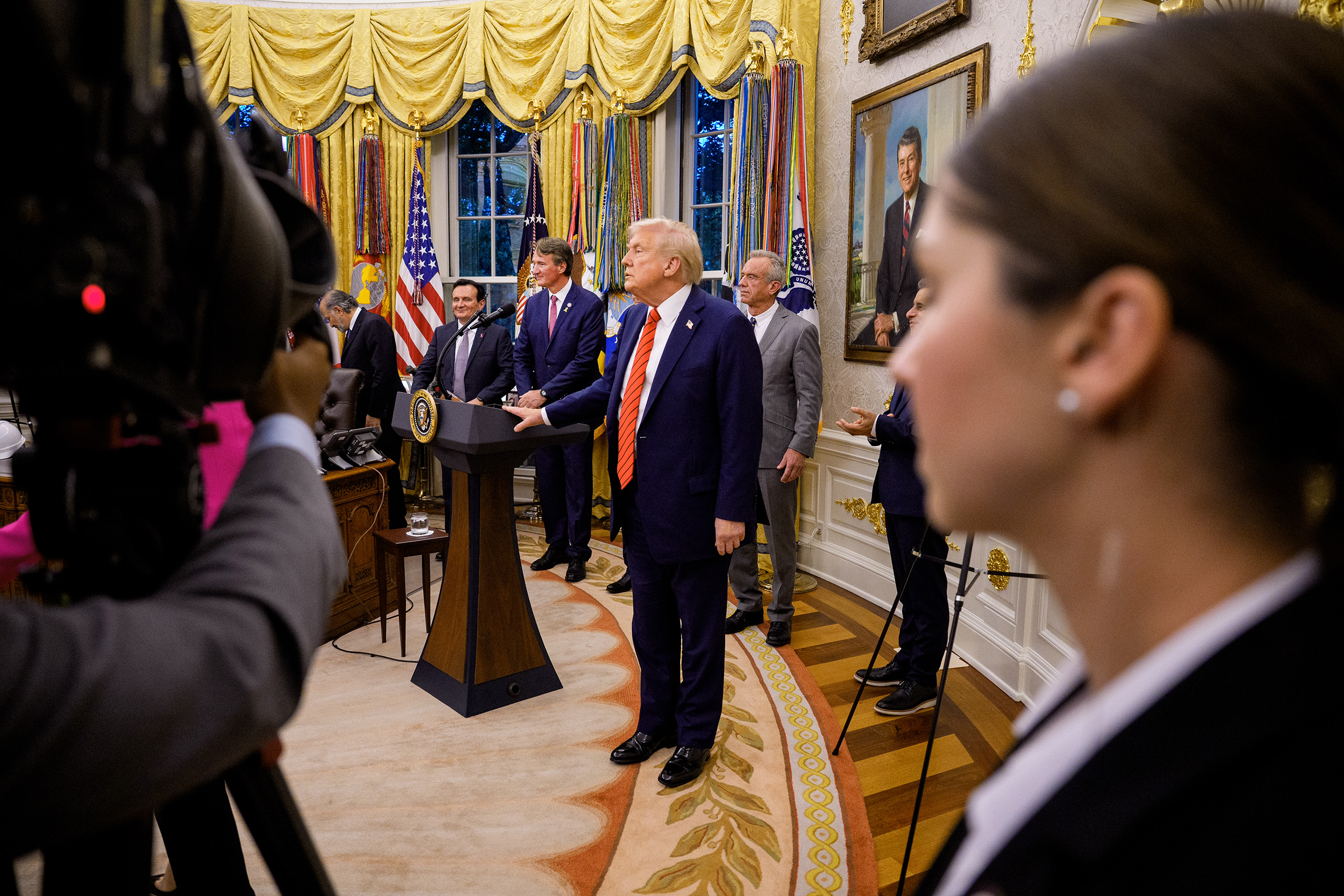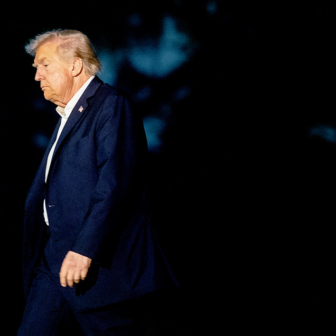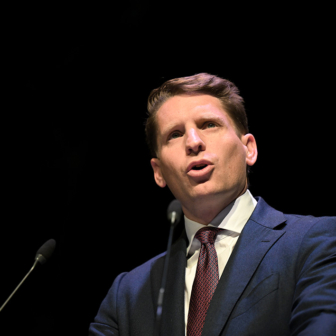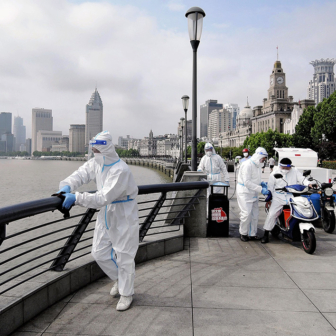Back in March, just two months into Donald Trump’s second presidential term, I wrote about the possible impact of Trump’s policies on Australia’s Pharmaceutical Benefits Scheme, or PBS. Despite heavy lobbying from the US industry group PhRMA, the many threats had so far yielded little action. But Trump’s erratic initiatives — even those putatively designed to deliver benefits to the American population — were nevertheless threatening to increase the price of pharmaceutical in the United States, Australia and elsewhere.
Trump has since ramped up his pledge to reduce what Americans pay for prescription drugs, in recent months making bold, mathematically impossible undertakings to cut drug prices by as much as 1500 per cent. But there is little evidence that Trump can achieve his stated aim and serious concern that his plans would create shortages, increase prices and disrupt research and development, drug approvals and manufacturing.
Americans have always paid more for brand-name prescription drugs than consumers in most other countries. A 2024 report by the RAND Corporation found that brand-name drugs cost at least four times more in the US than they do in comparison countries. (By contrast, unbranded generics, 90 per cent of US prescriptions, averaged 67 per cent of prices in comparison countries.) This largely reflects a complex and fragmented reimbursement system, the lack of national price control mechanisms and the industry’s zealously guarded patent protections.
Government-funded programs have failed to capitalise on their large-scale bargaining power. The Veterans’ Administration is unique in negotiating prices directly with manufacturers, and the Medicaid Drug Rebate Program requires drug manufacturers to negotiate prices with the states. But Medicare has been prohibited until very recently from negotiating the price of medications for seniors.
In the private sector, health insurers typically rely on intermediaries known as pharmacy benefit managers to negotiate costs, and hospitals and physicians’ offices charge insurers or patients whatever price they can negotiate. The lack transparency provides countless opportunities for mark-ups. Many Americans look for cheaper medicines from online pharmacies or import them from Canada, Mexico and elsewhere.
Trump’s threats and promises come in an environment in which many Americans struggle to access affordable medicines and healthcare and the immense lobbying power of the pharmaceutical industry. That power, and Trump’s inability to focus on any issue for a concerted period, is a major reason why his pharmaceutical price initiatives are so disjointed and contradictory.
The process started in February during a White House gathering of governors and new cabinet members at which Trump declared “Americans are being screwed” on drug costs. But then, in April, he issued an executive order directing the Department of Health and Human Services to work with Congress to modify the only recent attempt to reduce Medicare spending on prescription drugs. Pharmaceutical industry lobbying had already paid off handsomely.
Joe Biden’s Inflation Reduction Act enabled Medicare to negotiate prices for the most commonly used and expensive drugs the program covers. The first set of negotiated prices for just ten drugs — estimated to deliver annual savings of US$1.5 billion in out-of-pocket costs for Medicare beneficiaries and US$6 billion for the Medicare program — are not due to go into effect until 2026. Negotiated prices for another fifteen drugs, including blockbuster diabetes drugs like Ozempic, are due to be implemented in 2027.
The Republican Congress delivered on the industry’s demands in the One Big Beautiful Bill, which further limited which drugs can be included in Medicare’s negotiation program. The health policy centre KFF estimates that this change alone will increase Medicare spending by at least US$5 billion. It’s unclear whether the Trump administration will ever implement the previously agreed savings in 2026.
The April executive order also required disclosure of the direct and indirect compensation received by pharmacy benefit managers and a report on anti-competitive behaviour by prescription drug manufacturers. The required transparency regulations are yet to appear and several “listening sessions” on anti-competitive behaviours have yet to yield recommendations for reform.
There’s confusion and an irony in the fact that the April executive order attempted to make it easier for states to import prescription medicines, given that it came just one day after the Trump administration announced a national security report into the pharmaceutical industry as a precursor to the tariffs that were to come just a few months later.
An executive order issued in May aimed to tackle the disparities in drug prices between the United States and other high-income countries using voluntary “most-favoured-nation,” or MFN, pricing, under which prices in the United States could be lowered to match the lowest price in other similar markets. Non-compliance could trigger compulsion. “Big Pharma will either abide by this principle voluntarily,” Trump declared as he signed the order, “or we will use the power of the federal government to ensure that we are paying the same price as other countries to accelerate these price restrictions and reductions.”
Yet he also alleged European governments are the real enemy. Referring to what he described as “price gouging and profiteering,” he claimed it was “really the countries that forced Big Pharma to do things that, frankly, I’m not sure they really felt comfortable doing, but they’ve gotten away with it, these countries. The European Union has been brutal, brutal, and the drug companies actually told me stories — it was just brutal, how they forced them.”
The May executive order also requires a review of other countries’ policies and practices to pinpoint those that work against American interests — a review that will surely consider how Australia approves drugs for PBS listing — as well as efforts to facilitate direct-to-consumer purchasing programs at MFN prices.
This latter proposal reiterates a first-term attempt by Trump to benchmark prices for drugs administered in doctors’ offices to the lowest price in OECD countries — a move that encountered legal and political obstacles. The latest decision will face the same challenges, but for the moment it seems the administration is focused on what can be achieved through bargaining with individual pharmaceutical companies.
Discussions so far between the Department of Health and Human Services and the pharmaceutical industry have not yielded meaningful results. Big Pharma will fight hard to keep their largest and most profitable market. Their most potent argument is that cutting prices in the United States would stifle innovation by reducing funds for research and development. PhRMA used the same argument in a letter early this year to the US Trade Representative, saying that the Australia’s PBS pricing policies “undervalued American innovation.”
In a shift in focus, however, the pharmaceutical industry took the view that Trump’s tariff policies could be used decrease the gap between prices in the United States and Europe (and Australia) by forcing governments in these countries to stop bargaining down prices. “European governments are not signing up to pay more for drugs. We need trade tools to rebalance that equation,” said the CEO of one large international pharmaceutical company.
Such an approach would protect only the profits of the pharmaceutical industry, of course, and would do nothing to reduce prices for governments or patients. In fact, there is near-universal agreement that prices would actually increase in the United States and shortages of some medicines would be exacerbated.
Undeterred, Trump announced that a 100 per cent tariff will be levied on any branded or patented pharmaceutical product from 1 October “unless a Company IS BUILDING their Pharmaceutical Manufacturing Plant in America.” Given that he previously suggested tariffs would be phased more slowly, giving companies time to build factories and relocate production, this announcement came as a shock to companies outside the US.
The tariff edict was not the subject of an executive order and came with little detail. Trump’s threats had already spurred international pharmaceutical companies to announce billions of dollars of investments in their US operations. Trump had agreed in July to the framework of a deal with the European Union — where nearly all of the biggest companies have a significant manufacturing presence — that would levy only a 15 per cent tariff on drug imports, with some exceptions for certain generic drugs. A framework agreement with Japan, meanwhile, applied a baseline 15 per cent tariff to nearly all Japanese imports, with an exemption for generic drugs.
Whether these deals hold or have been abandoned isn’t clear. Carve-outs for European and Japanese exports and companies engaged in US manufacturing could shield most branded drugs from the 100 per cent levy. But it’s feared the tariffs will have the greatest impact on drugs for rare diseases and speciality pharmaceuticals from smaller manufacturers without an American presence.
Australian company CSL is hoping that its US-based facilities and large workforce will protect its exports of vaccines, anti-venoms and blood product to the United States. Blood products made up 87 per cent of the A$2.1 billion in medicinal and pharmaceutical products exported to the United States in 2024. Made from blood plasma collected in the United States and fractionated in Melbourne, these products are used in a range of medical and surgical treatments, including responses to a number of life-threatening diseases. Any increase in prices would have serious health and financial consequences for many Americans.
For the moment these concerns are in abeyance because the implementation of these tariffs has been paused while individual negotiations continue. Just this month Trump has revealed deals with Pfizer and Astra Zeneca. These companies will participate in a new direct purchasing platform named TrumpRx.gov that will let American patients buy a “large majority” of their products at a discount. In return, Pfizer and Astra Zeneca will receive a three-year reprieve from certain tariffs. Trump called this “bringing MFN pricing to American patients” but it is a long way from that.
There are concerns that TrumpRx is yet another move by the Trump family to cash in on the presidency and that the brand name will discourage some Americans from using it. There are also doubts about its ability to compete with the other, similar online pharmacy services that have proliferated in the United States, and about the actual the discounts to be offered. It’s seen as a win for the companies, with very modest gains for consumers. More companies are expected to join.
The White House is now saying it may not need to impose tariffs. Asked earlier this month when pharmaceutical tariffs would go into effect, commerce secretary Howard Lutnick said the administration is “going to let [the talks] play out and finish these negotiations, because they are the most important thing to the American people.”
In all this activity, two key areas have been ignored. First, generic drugs, which account for more than 90 per cent of prescriptions and 10 per cent of costs, are mostly imported from places like China (currently subject to a 30 per cent tariff) and India (a 50 per cent tariff). The tariff on imported Indian generics is estimated to increase US healthcare spending by roughly US$7 billion.
Second, in the push to increase onshore manufacturing, little attention is paid to why drug manufacturers move operations overseas in the first place. The pharmaceutical industry is a global web, with ingredients and finished drugs manufactured in a multitude of locations based in costs and expertise. Much of the US expertise in science and medicine is meanwhile being actively undermined by Trump policies on research funding. These issues, neither of them readily addressed under Trump’s current policies, explain why America imported nearly US$233 billion in pharmaceutical and medicinal products in 2024.
As prime minister Anthony Albanese heads to Washington for much-vaunted talks this week, there is considerable speculation about topics for discussion. Will Australia quietly accept 10 per cent tariffs as a best-case scenario, or will Albanese push for fairness based on Australia’s trade deficit (Australia contributes less than 1 per cent to the US trade deficit in pharmaceuticals) and existing trade agreements? Whether the PBS is still on the table will depend on who has had Trump’s ear last — including the well-funded lobbyists from Big Pharma.
The Saturday Paper’s Jason Koutsoukis recently pointed out that Australia is one of the two or three countries most likely to set the MFN prices in the United States; it topped a Trump administration list of eighteen countries in a “MFN basket” for reference pricing. Koutsoukis reports that health minister Mark Butler is engaged in talks designed to protect the PBS. Let’s hope Butler recognises that the Australian pharmaceutical companies whose US-based parent companies see the PBS as a free-rider undermining their profits are not the Albanese government’s allies in this fight. •




